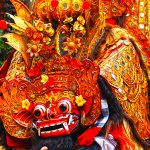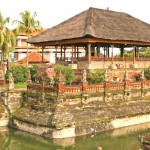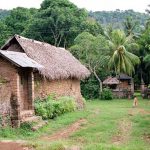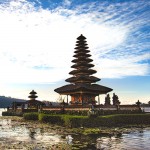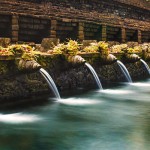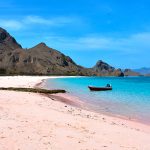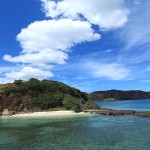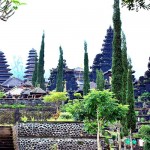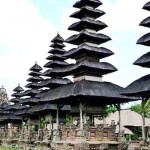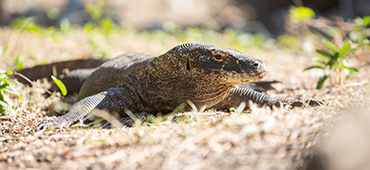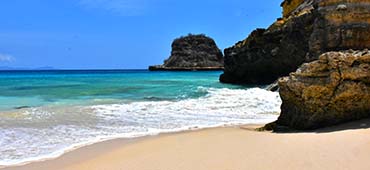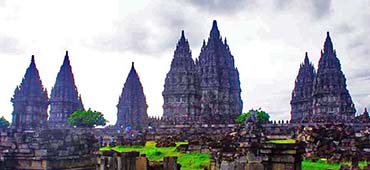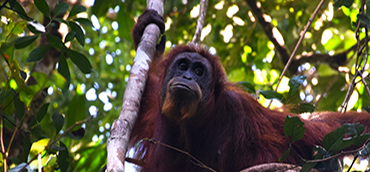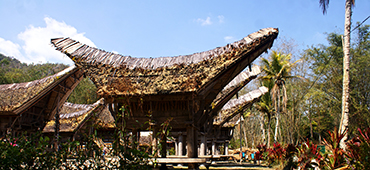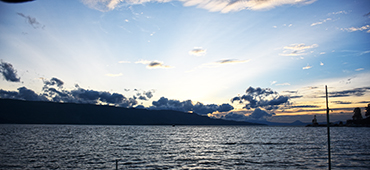Goa Gaja; Elephant Cave
Goa Gajah-Elephant Cave- Ubud is an artificial cave from ancient times that functions as a place of worship. This cave is located in Bedulu Village, Blahbatuh District, Gianyar Regency, Bali; is approximately 27 km from Denpasar. The name Lwa Gajah, was first mentioned in the literary work of Kakawin Nagarakretagama compiled by Mpu Prapanca (1365 AD). The name is listed in the pupuh which describes the areas to the east of Java, which recognized Majapahit rule. Lwa or Lwah / Loh means river, so Lwa Gajah means Elephant River; possibly the river located in front of the temple which is now known as the Petanu River.
The name Elephant Cave probably comes from the carving of a giant face above the mouth of the cave, which is thought to resemble an elephant’s face. Another source states that the name was caused by the presence of a statue of Ganesha, the elephant-headed god, in one of the recesses in the cave.
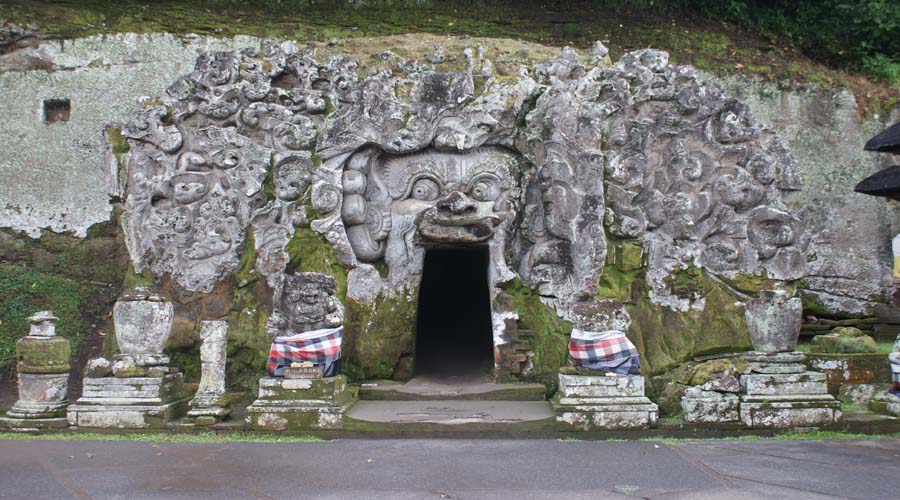 History
History
The discovery of the Elephant Cave originated from a report by the Dutch East Indies official, LC. Heyting in 1923 who found statues of Ganesha, Trilingga and statues of Hariti to the Dutch East Indies government. This was followed up by Dr. WF. Stutterheim to carry out further research in 1925. In 1950 the Indonesian Archaeological Service through sections of ancient buildings in Bali led by JL Krijgman conducted research and excavations from 1954 to 1979 and found an ancient petirtaan place with 6 female statues (angel ) with a shower of water on the chest and until now its existence can be trusted to provide aura purification vibrations for visitors.
In 1931 Mr. Conrat Spies also found a significant relic in the Tukad Pangkung complex in the form of a three-branched stupa carved into a collapsed stone wall lying at the base of Pangkung River. Since 1950, after the Archaeological Agency of the Republic of Indonesia opened a branch office in Bali, which is domiciled in Gianyar under the leadership of J.C. Krijgsman, research on ancient relics in Gua Gajah received special attention. This was proven in 1951/1952 when excavations were held in the front yard of the cave mouth. From the excavation, an ancient foundation was found in the shape of a rectangle, in which the front wall of the cave is one of its long sides.
In that year cracks were also discovered in the ceiling of the cave as a result of the roots of a Frangipani tree growing on the cliff to the right of the cave’s mouth. During the cleaning of the soil and roots in the western part of the cave, two pieces of rock were found, the first fragment was the top of a giant head above the cave hole, the second fragment was the carved part of the eastern wall. Besides that, there was also found a sword made of solid stone which is part of a giant statue in front of the cave.
The Elephant Cave Complex consists of 2 main parts, namely the northern complex which is a legacy of Shiva teachings, with evidence of the Trilingga and a Ganesha statue in the cave, which is a place for Hindus to pray. The complex to the south of the Elephant Cave is the Tukad Pangkung area, in the form of ruins of a Buddhist stupa in the form of a 13-tiered umbrella and a 3-branched stupa carved into a large rock.
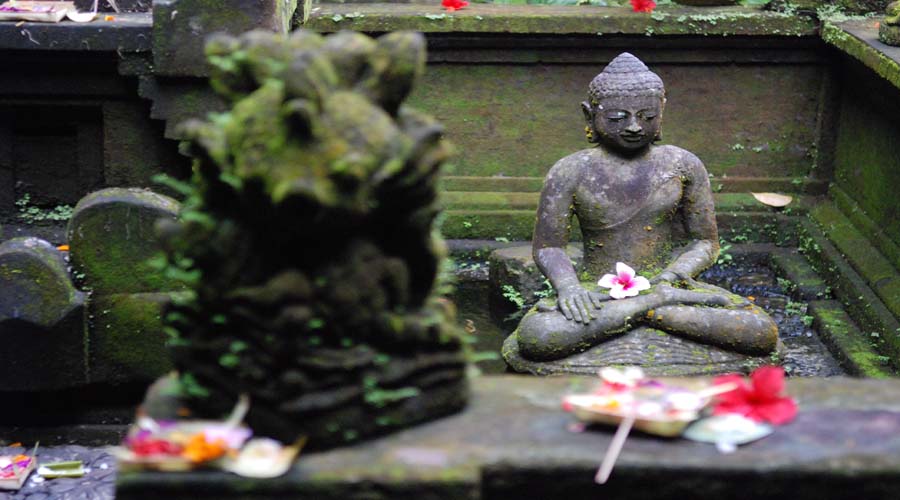 Northern part
Northern part
The northern complex is centered on a cave-temple known as Gua Gajah. The cave is carved into hard solid rock that juts out 5.75-meters from the rock wall, measures 6.75-meters high and 8.6 meters wide. The surface of the cave faces south, decorated with motifs of leaves, rocks, giants, monkeys and pigs. In the middle of the relief there is a cave opening with a width of 1 meter and a height of 2 meters. On the threshold of the cave’s mouth is a hideous sculpture of a giant face with big round eyes glancing to the right; rough hair and eyebrows, big nose, upper lip with a row of teeth just above the cave opening. On the east wall of the cave there are two lines of writing that read kumon and the bottom row of sahy (w) goose; which judging from the shape of the letters is thought to have come from the 11th century.
The passage in the cave is shaped like the letter T. After entering a few meters to the north, there is a passage that runs across the west-east direction. The corridor that stretches from east-west measures 13.5 meters long, 2.75 meters wide and 2 meters high. On the north wall of the transverse passage there are 7 recesses, one of which faces the entrance to the cave and is the largest one with a height of 1.26 meters, a depth of 1.35 meters, located 0.7 meters from the ground. Inside there are fragments of giant statues and fragments of Shiva statues. At both ends of the passage, there is also an alcove. The niche at the eastern end contains a trilingga and the niche at the western end contains a Ganesha statue.
In front of Gua Gajah, there are several ancient statues depicting Hariti, Ganesha, and the giant. The Hariti character (in Avesta Harauhuti language) in Buddhist tales is known as a character with an evil character and likes to prey on children; however after studying Buddhism he turned into a child lover. The statue depicts Hariti with three children each on his right and left and one child on his lap. In Balinese fairy tales, Hariti is better known as Men Brayut (or Nini Brayut in the Javanese tradition).
A bathing complex or petirtaan is located in front of Gua Gajah, a little down. The bath is composed of three sacred bathing pools lined north-south, with six (supposedly seven) broken statues at the edges. Each pair of statues consists of a statue of a angel flanked by two statues of an angel, facing a large pond. The statue by the pool which is missing or has not been found, is probably a broken Ganesh statue that was found decorating the edge of the cave’s mouth. Initially found in a messy condition and covered by earth, even by new buildings, this bathhouse was then successfully excavated and reconstructed in 1954 thanks to J.L. Krijgman, at that time the Head of the Archaeological Office in Bali.
These statues of nymphs and angels stand on lotus or lotus mats. Padma is a symbol of Hyang Widhi’s universe. Meanwhile, in the middle lies the widyadara statue. This is based on the Sapta Nadi concept, namely the seven sacred rivers of Ganges, Sindhu, Saraswati, Yamuna, Godawari, Serayu and Narmada.
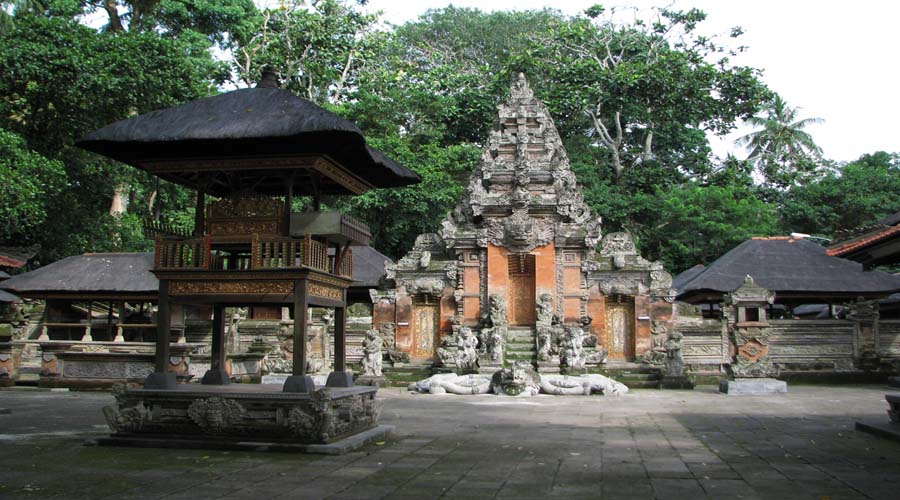 South side
South side
A little far from the northern complex, there is a southern complex located in a ravine or valley known as Tukad Pangkung. This area is in the form of a valley of the Patapan temple, and here is a Buddha statue stored. [6] In this valley there is an ancient relic in the form of a large relief that has collapsed to the bottom of the valley, which may have been part of a cliff-temple.
The large relief carved into the rock consisted of several parts. The first is in the form of a stupa fragment with three branches, with the tops of which are tiled umbrellas. Next to it is another stupa fragment, with one top of a tiered umbrella. And above the two reliefs, you can see the lower part of a Buddha statue. Meanwhile, not far away, there are also ruins of relief fragments in the form of a 13-tiered umbrella, which may have been the top of a stupa like the other reliefs. Seeing the shape, these reliefs are estimated to be much older than the Elephant Cave in the north; probably from the early 10th century.
Function
From the data in the field, it can be stated that the Elephant Cave site is a sacred place as a center for Hindu and Buddhist religious activities during the reign of the Warmadewa dynasty from the X-XIV century AD (400 years). The status of the Gajah Cave site is now a living monument functioning as a place for religious activities (Pura) and the community calls it the Cave Temple.
Based on the findings of archaeological data at the Gua Gajah site, several things can be stated as follows: – Of the several inscriptions that have been presented in Bali, none of them directly mention the name Elephant Cave, but the additional Songan Inscription issued by King Marakata dates back to 1022 AD and the Cempaga Inscription issued by King Sri Mahaguru which dates from 1324 AD, both mention the name Er Gajah. Then the Dawan inscription in 1053 AD and the Pandak Badung inscription in 1071 AD mentions the Antakunjarapadda holy place (Kunjara = elephant). Meanwhile, in the book Negarakertagama in 1365 AD, the names Badulu and Lwa Gajah are listed, which are two places in Bali which are included in the list of areas controlled by the Majapahit Kingdom.




